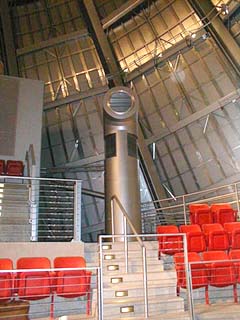|
Subscribe / Renew |
|
|
Contact Us |
|
| ► Subscribe to our Free Weekly Newsletter | |
| home | Welcome, sign in or click here to subscribe. | login |
Architecture & Engineering
| |
 |
June 6, 2002
What would Mr. Wizard do?
Notkin Engineering

Photo courtesy of Notkin Engineering This architecturally designed "ship horn" is a supply air diffuser that keeps visitors and artists cool in the hot shop through a "wind-chill effect," using natural ventilation instead of costly air conditioning. |
The design of the hot shop amphitheater was a science challenge that mechanical engineers love to solve, much as Don Herbert, TV's Mr. Wizard, would.
Among the biggest challenges was devising a way for 130 schoolchildren to sit comfortably in an industrial hot shop or peer over a railing from an overhead platform while safely experiencing blasts of convective heat escaping from the glass furnaces. Artists, too, needed protection from the furnaces, from which radiant heat tops 2,000 degrees.
Gathering data
To address these challenges, we did what Mr. Wizard would do: gather data. Along with the architect and other key team members, Notkin's John Augenstein visited leading industrial and art facilities with hot shops.
A visit to UrbanGlass, a glass arts center in Brooklyn, New York, was important because it was a studio inside a building, similar to what was envisioned for the Museum of Glass.
The Corning glass factory in Corning, New York, had stadium seating in the hot shop as well as a cold shop with lab benches, where people could do intricate work with sanders and smoothing devices -- a feature the Museum of Glass also wanted to incorporate.
"We quickly narrowed our focus by watching how the spaces were used and how people worked as teams to create the art in a hot shop environment, " said Augenstein. "It was important to see how the velocity and direction of air flow into the capture canopies of the furnaces had to be carefully controlled because if the air moves too quickly it can cause rapid cooling of the art and ruin it."
Another important outcome was defining the differences between containment of radiant vs. conductive heat. (Now we're getting into Mr. Wizard talk.) For example, why do you feel warmer when you stand in the sun? Even though it is 75 degrees whether you are standing in the shade or in the open, the difference is the radiant heat effect.
"Heat loads in a hot shop can be easily underestimated," said Dick Geoghegan, a Notkin senior engineer who analyzed equipment characteristics and their impacts to the space.
Moving air
What we wanted to achieve had not been done before in any of the facilities we visited. Geoghegan added that very little research on human comfort has been done at similar temperature ranges and velocities.
The solution was a system that offered relief from the radiant effect of 2,000-plus-degree furnaces using a combination of wind and heat shields.
To offset the heat radiating from the furnaces, a "wind-chill effect" was created by washing a uniform flow of air across the audience and the artists. One source is behind the seating area where an art fabric conceals a large supply air plenum. Air is released at a very slow velocity, falling on people.
To increase air movement, two supply towers, which look like ship horns on either side of the room, push air across the room from opposite directions. This air comes from the lungs of the building -- the air-handling systems in the mechanical room. A third vent cools artists at floor level in the equipment enclosure.
To minimize the surface areas radiating heat, heat shields slide across the furnaces like barn doors so that only the glass-firing furnaces are exposed. A hood or shroud extends beyond the front of the equipment so that blasts of convective heat coming out of the furnace do not endanger the artist or affect pedestrians on the overhead ramp.
Saving energy
It takes a tremendous amount of energy to melt glass, and it would take too much energy to re-melt glass, so the furnaces are rarely turned off. What, then, is happening to all that heat escaping from the cone?
By using a heat-recovery coil in the exhaust airstream of the cone, air is passed over the coil and the heat is extracted and distributed to a hot-water heating loop. This captured energy heats domestic hot water and also the rest of the building, saving an estimated 4 million cubic feet of fuel annually.
Although the building was designed before the U.S. Green Building Council’s environmental rating system was created, the building would meet many of its new requirements in terms of using advanced controls, heat recovery systems and use of natural ventilation (rather than air conditioning) in the hot shop.
Mr. Wizard would be proud to see how science was used to create the "best of the best" in a unique museum -- a place where art is truly fused with industrial magic.
Sandra G. Bonderman is a partner at Notkin Engineering and project manager for the Museum of Glass.
Other Stories:


